AC4052 Financial Accounting: Analyzing ASOS PLC's Financial Health
VerifiedAdded on 2023/06/10
|9
|2616
|396
AI Summary
This coursework provides a detailed financial analysis of ASOS PLC for the years 2020 and 2021, including calculations and interpretations of key financial ratios such as Return on Capital Employed, Net Profit Margin, and Asset Turnover. It also assesses the company's working capital, liquidity, and long-term financing strategies. Additionally, the coursework includes the preparation of financial statements (statement of profit or loss, statement of changes in equity, and statement of financial position) for Giorgio F PLC, and the creation of a cash budget and profit budget for Grazyna Ltd, offering a comprehensive overview of financial accounting principles and practices. The assignment uses financial data to evaluate company performance and financial health.
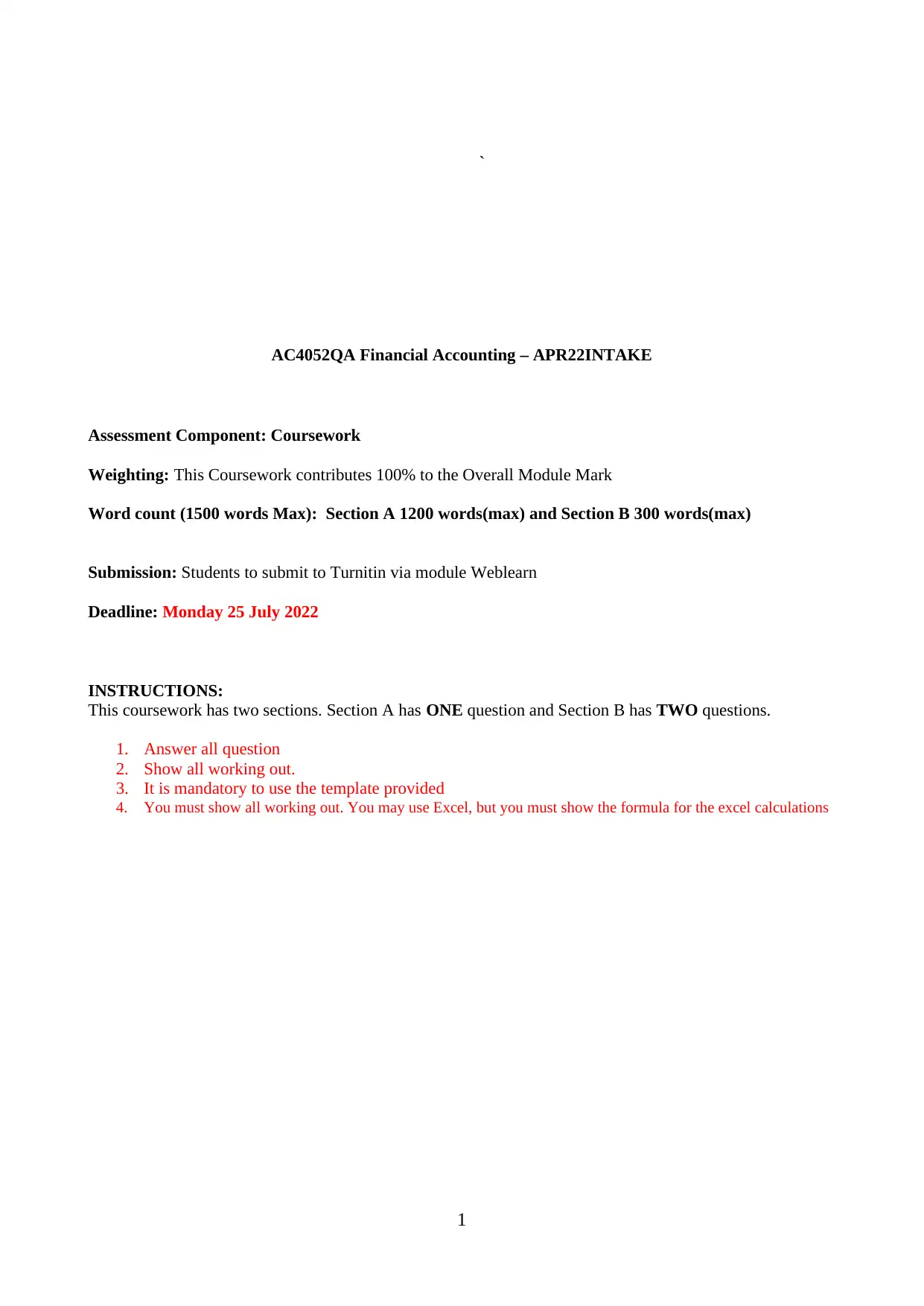
`
AC4052QA Financial Accounting – APR22INTAKE
Assessment Component: Coursework
Weighting: This Coursework contributes 100% to the Overall Module Mark
Word count (1500 words Max): Section A 1200 words(max) and Section B 300 words(max)
Submission: Students to submit to Turnitin via module Weblearn
Deadline: Monday 25 July 2022
INSTRUCTIONS:
This coursework has two sections. Section A has ONE question and Section B has TWO questions.
1. Answer all question
2. Show all working out.
3. It is mandatory to use the template provided
4. You must show all working out. You may use Excel, but you must show the formula for the excel calculations
1
AC4052QA Financial Accounting – APR22INTAKE
Assessment Component: Coursework
Weighting: This Coursework contributes 100% to the Overall Module Mark
Word count (1500 words Max): Section A 1200 words(max) and Section B 300 words(max)
Submission: Students to submit to Turnitin via module Weblearn
Deadline: Monday 25 July 2022
INSTRUCTIONS:
This coursework has two sections. Section A has ONE question and Section B has TWO questions.
1. Answer all question
2. Show all working out.
3. It is mandatory to use the template provided
4. You must show all working out. You may use Excel, but you must show the formula for the excel calculations
1
Paraphrase This Document
Need a fresh take? Get an instant paraphrase of this document with our AI Paraphraser
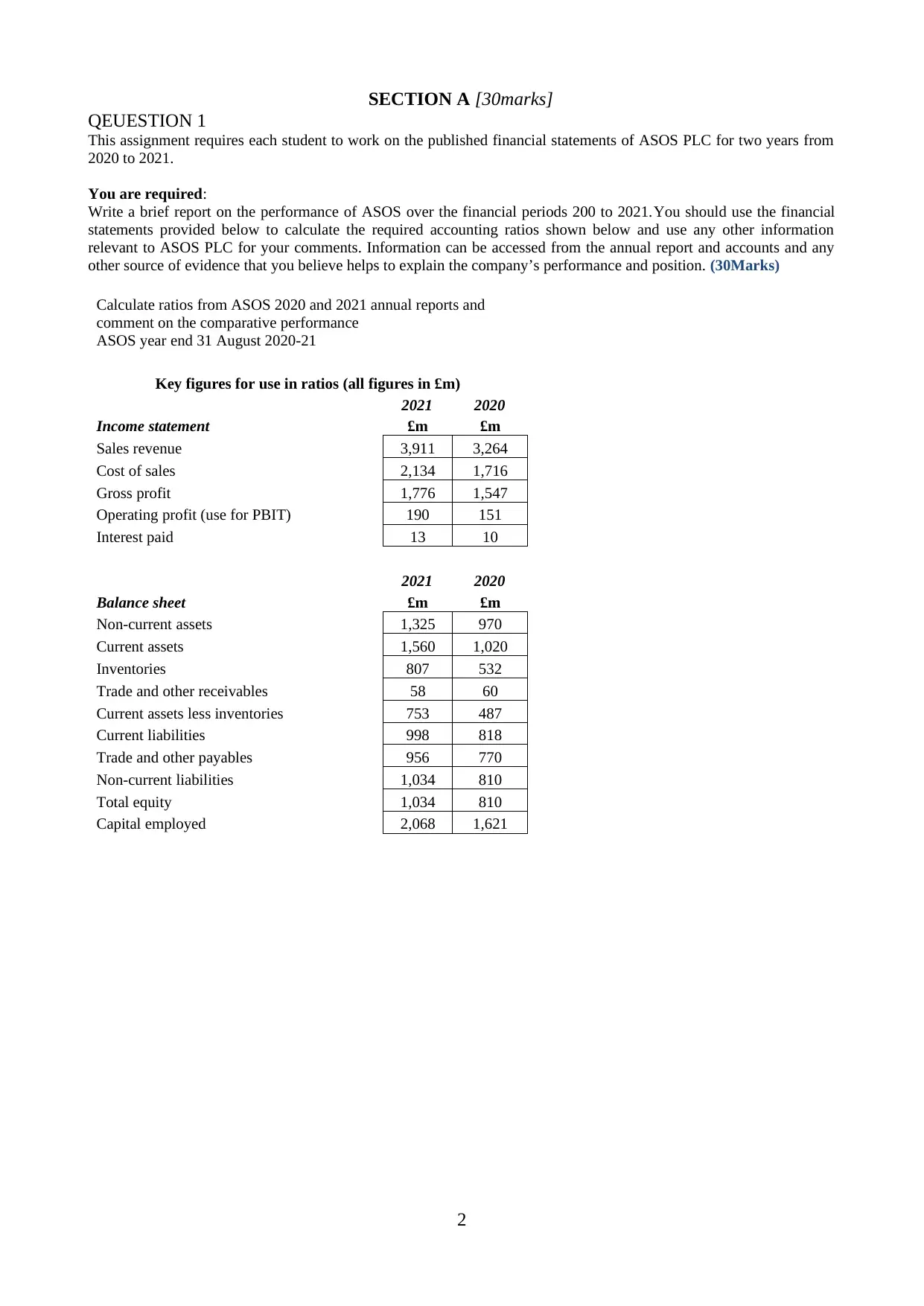
SECTION A [30marks]
QEUESTION 1
This assignment requires each student to work on the published financial statements of ASOS PLC for two years from
2020 to 2021.
You are required:
Write a brief report on the performance of ASOS over the financial periods 200 to 2021.You should use the financial
statements provided below to calculate the required accounting ratios shown below and use any other information
relevant to ASOS PLC for your comments. Information can be accessed from the annual report and accounts and any
other source of evidence that you believe helps to explain the company’s performance and position. (30Marks)
Calculate ratios from ASOS 2020 and 2021 annual reports and
comment on the comparative performance
ASOS year end 31 August 2020-21
Key figures for use in ratios (all figures in £m)
2021 2020
Income statement £m £m
Sales revenue 3,911 3,264
Cost of sales 2,134 1,716
Gross profit 1,776 1,547
Operating profit (use for PBIT) 190 151
Interest paid 13 10
2021 2020
Balance sheet £m £m
Non-current assets 1,325 970
Current assets 1,560 1,020
Inventories 807 532
Trade and other receivables 58 60
Current assets less inventories 753 487
Current liabilities 998 818
Trade and other payables 956 770
Non-current liabilities 1,034 810
Total equity 1,034 810
Capital employed 2,068 1,621
2
QEUESTION 1
This assignment requires each student to work on the published financial statements of ASOS PLC for two years from
2020 to 2021.
You are required:
Write a brief report on the performance of ASOS over the financial periods 200 to 2021.You should use the financial
statements provided below to calculate the required accounting ratios shown below and use any other information
relevant to ASOS PLC for your comments. Information can be accessed from the annual report and accounts and any
other source of evidence that you believe helps to explain the company’s performance and position. (30Marks)
Calculate ratios from ASOS 2020 and 2021 annual reports and
comment on the comparative performance
ASOS year end 31 August 2020-21
Key figures for use in ratios (all figures in £m)
2021 2020
Income statement £m £m
Sales revenue 3,911 3,264
Cost of sales 2,134 1,716
Gross profit 1,776 1,547
Operating profit (use for PBIT) 190 151
Interest paid 13 10
2021 2020
Balance sheet £m £m
Non-current assets 1,325 970
Current assets 1,560 1,020
Inventories 807 532
Trade and other receivables 58 60
Current assets less inventories 753 487
Current liabilities 998 818
Trade and other payables 956 770
Non-current liabilities 1,034 810
Total equity 1,034 810
Capital employed 2,068 1,621
2
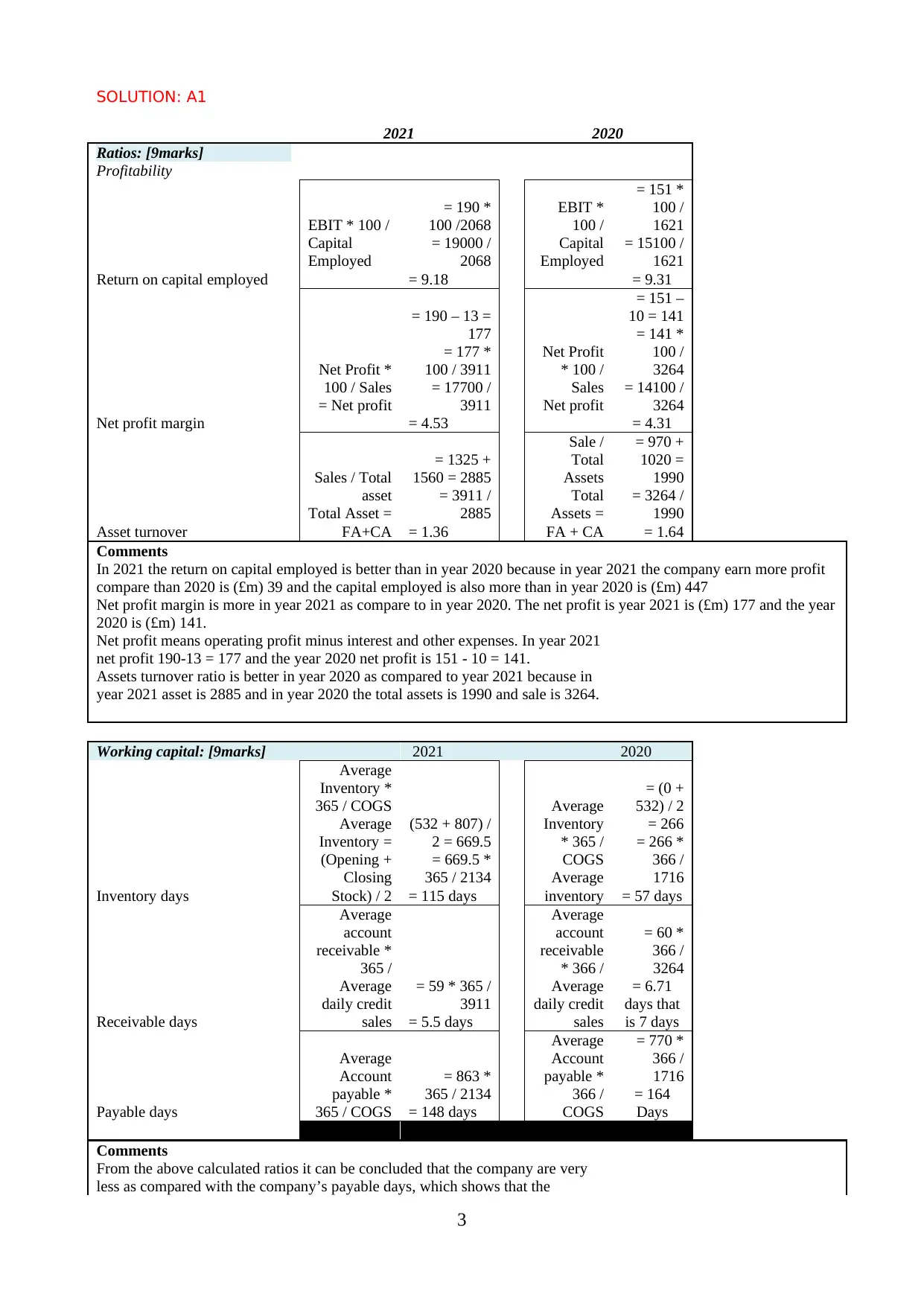
SOLUTION: A1
2021 2020
Ratios: [9marks]
Profitability
Return on capital employed
EBIT * 100 /
Capital
Employed
= 190 *
100 /2068
= 19000 /
2068
= 9.18
EBIT *
100 /
Capital
Employed
= 151 *
100 /
1621
= 15100 /
1621
= 9.31
Net profit margin
Net Profit *
100 / Sales
= Net profit
= 190 – 13 =
177
= 177 *
100 / 3911
= 17700 /
3911
= 4.53
Net Profit
* 100 /
Sales
Net profit
= 151 –
10 = 141
= 141 *
100 /
3264
= 14100 /
3264
= 4.31
Asset turnover
Sales / Total
asset
Total Asset =
FA+CA
= 1325 +
1560 = 2885
= 3911 /
2885
= 1.36
Sale /
Total
Assets
Total
Assets =
FA + CA
= 970 +
1020 =
1990
= 3264 /
1990
= 1.64
Comments
In 2021 the return on capital employed is better than in year 2020 because in year 2021 the company earn more profit
compare than 2020 is (£m) 39 and the capital employed is also more than in year 2020 is (£m) 447
Net profit margin is more in year 2021 as compare to in year 2020. The net profit is year 2021 is (£m) 177 and the year
2020 is (£m) 141.
Net profit means operating profit minus interest and other expenses. In year 2021
net profit 190-13 = 177 and the year 2020 net profit is 151 - 10 = 141.
Assets turnover ratio is better in year 2020 as compared to year 2021 because in
year 2021 asset is 2885 and in year 2020 the total assets is 1990 and sale is 3264.
Working capital: [9marks] 2021 2020
Inventory days
Average
Inventory *
365 / COGS
Average
Inventory =
(Opening +
Closing
Stock) / 2
(532 + 807) /
2 = 669.5
= 669.5 *
365 / 2134
= 115 days
Average
Inventory
* 365 /
COGS
Average
inventory
= (0 +
532) / 2
= 266
= 266 *
366 /
1716
= 57 days
Receivable days
Average
account
receivable *
365 /
Average
daily credit
sales
= 59 * 365 /
3911
= 5.5 days
Average
account
receivable
* 366 /
Average
daily credit
sales
= 60 *
366 /
3264
= 6.71
days that
is 7 days
Payable days
Average
Account
payable *
365 / COGS
= 863 *
365 / 2134
= 148 days
Average
Account
payable *
366 /
COGS
= 770 *
366 /
1716
= 164
Days
Comments
From the above calculated ratios it can be concluded that the company are very
less as compared with the company’s payable days, which shows that the
3
2021 2020
Ratios: [9marks]
Profitability
Return on capital employed
EBIT * 100 /
Capital
Employed
= 190 *
100 /2068
= 19000 /
2068
= 9.18
EBIT *
100 /
Capital
Employed
= 151 *
100 /
1621
= 15100 /
1621
= 9.31
Net profit margin
Net Profit *
100 / Sales
= Net profit
= 190 – 13 =
177
= 177 *
100 / 3911
= 17700 /
3911
= 4.53
Net Profit
* 100 /
Sales
Net profit
= 151 –
10 = 141
= 141 *
100 /
3264
= 14100 /
3264
= 4.31
Asset turnover
Sales / Total
asset
Total Asset =
FA+CA
= 1325 +
1560 = 2885
= 3911 /
2885
= 1.36
Sale /
Total
Assets
Total
Assets =
FA + CA
= 970 +
1020 =
1990
= 3264 /
1990
= 1.64
Comments
In 2021 the return on capital employed is better than in year 2020 because in year 2021 the company earn more profit
compare than 2020 is (£m) 39 and the capital employed is also more than in year 2020 is (£m) 447
Net profit margin is more in year 2021 as compare to in year 2020. The net profit is year 2021 is (£m) 177 and the year
2020 is (£m) 141.
Net profit means operating profit minus interest and other expenses. In year 2021
net profit 190-13 = 177 and the year 2020 net profit is 151 - 10 = 141.
Assets turnover ratio is better in year 2020 as compared to year 2021 because in
year 2021 asset is 2885 and in year 2020 the total assets is 1990 and sale is 3264.
Working capital: [9marks] 2021 2020
Inventory days
Average
Inventory *
365 / COGS
Average
Inventory =
(Opening +
Closing
Stock) / 2
(532 + 807) /
2 = 669.5
= 669.5 *
365 / 2134
= 115 days
Average
Inventory
* 365 /
COGS
Average
inventory
= (0 +
532) / 2
= 266
= 266 *
366 /
1716
= 57 days
Receivable days
Average
account
receivable *
365 /
Average
daily credit
sales
= 59 * 365 /
3911
= 5.5 days
Average
account
receivable
* 366 /
Average
daily credit
sales
= 60 *
366 /
3264
= 6.71
days that
is 7 days
Payable days
Average
Account
payable *
365 / COGS
= 863 *
365 / 2134
= 148 days
Average
Account
payable *
366 /
COGS
= 770 *
366 /
1716
= 164
Days
Comments
From the above calculated ratios it can be concluded that the company are very
less as compared with the company’s payable days, which shows that the
3
⊘ This is a preview!⊘
Do you want full access?
Subscribe today to unlock all pages.

Trusted by 1+ million students worldwide

company is being able to receive the payment from its creditors within a very
short period of time. On the other hand, the company has to pay the amount to
the its creditors in very long period of time. The company has to make payment
in approximately 5 months.
Liquidity: [6marks] 2021 2020
Current ratio
Current
Asset /
Current
liabilities
= 1560 / 998
= 1.56 Times
Current
Asset /
Current
liabilities
= 1020 /
818
= 1.24
Times
Acid test
(CA –
Inventory) /
CL
= (1560 –
807) / 998
= 0.75 Times
(CA –
Inventory)
/ CL
= (1020-
532) /
818
= 0.60
Times
Comments
From the above calculated liquidity ratio it can be concluded that the firm is having sufficient amount of current assets
to meet the current obligations of the company. Company has sufficient amount of current assets to pay off its current
liabilities of the business concern. Acid test ratio of the company states that the company is company’s liquidity is less
as compared with its current assets.
Long- term financing:
[3marks] 2021 2020
Gearing Equity / Debt
= 1034 /
1034
= 1 Times
Equity /
Debt
= 810 /
810
= 1 Times
Comments
From the above calculated ratio it suggests that the company is using a mix which is which shows that the company is
using equal amount of debt and equity in the organisation. On the other the hand, the ideal debt equity mix is 2:1 which
states the debt is used twice the equity. The company has increased its financial requirement by increasing both equity
and liability by the same amount.
Marking criteria for section A:
Explanatory comments on the assessment
criteria
Maximum marks for each section
Recommended marks
Assessment criteria:
(Guidelines – suggested –under FOUR MAIN
HEADINGS)
Correct answers Calculations (18 marks): 2marks each -
1mark for 2020, 1 mark for 2021
Interpretation of ratios
(comparative comments)
Relevance, clear demonstration of understanding
and applied in context
(9 Marks): 1marks for each specific ratio
Conclusion/
Recommendations
Identifying the key points raised (3marks)
4
short period of time. On the other hand, the company has to pay the amount to
the its creditors in very long period of time. The company has to make payment
in approximately 5 months.
Liquidity: [6marks] 2021 2020
Current ratio
Current
Asset /
Current
liabilities
= 1560 / 998
= 1.56 Times
Current
Asset /
Current
liabilities
= 1020 /
818
= 1.24
Times
Acid test
(CA –
Inventory) /
CL
= (1560 –
807) / 998
= 0.75 Times
(CA –
Inventory)
/ CL
= (1020-
532) /
818
= 0.60
Times
Comments
From the above calculated liquidity ratio it can be concluded that the firm is having sufficient amount of current assets
to meet the current obligations of the company. Company has sufficient amount of current assets to pay off its current
liabilities of the business concern. Acid test ratio of the company states that the company is company’s liquidity is less
as compared with its current assets.
Long- term financing:
[3marks] 2021 2020
Gearing Equity / Debt
= 1034 /
1034
= 1 Times
Equity /
Debt
= 810 /
810
= 1 Times
Comments
From the above calculated ratio it suggests that the company is using a mix which is which shows that the company is
using equal amount of debt and equity in the organisation. On the other the hand, the ideal debt equity mix is 2:1 which
states the debt is used twice the equity. The company has increased its financial requirement by increasing both equity
and liability by the same amount.
Marking criteria for section A:
Explanatory comments on the assessment
criteria
Maximum marks for each section
Recommended marks
Assessment criteria:
(Guidelines – suggested –under FOUR MAIN
HEADINGS)
Correct answers Calculations (18 marks): 2marks each -
1mark for 2020, 1 mark for 2021
Interpretation of ratios
(comparative comments)
Relevance, clear demonstration of understanding
and applied in context
(9 Marks): 1marks for each specific ratio
Conclusion/
Recommendations
Identifying the key points raised (3marks)
4
Paraphrase This Document
Need a fresh take? Get an instant paraphrase of this document with our AI Paraphraser
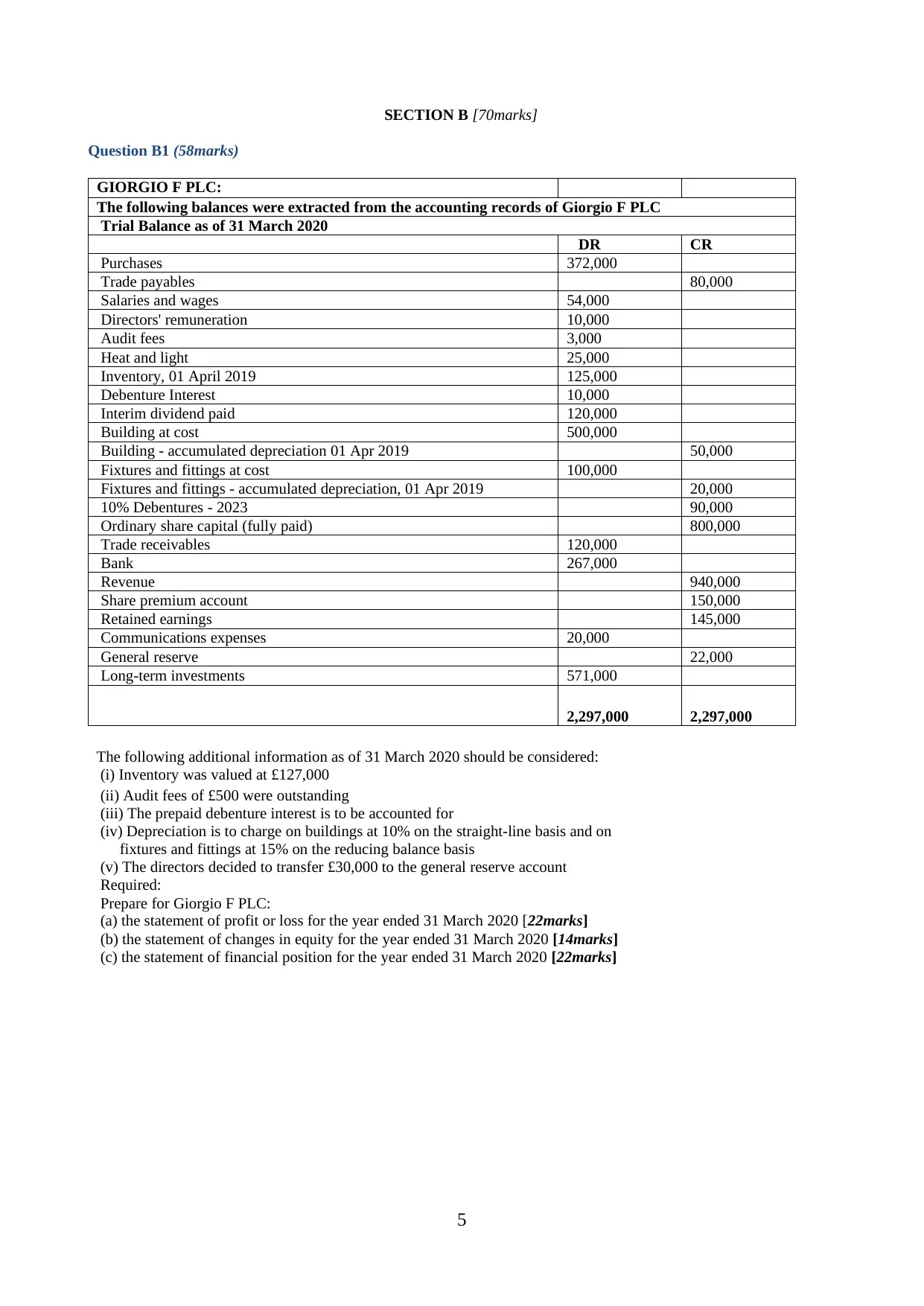
SECTION B [70marks]
Question B1 (58marks)
GIORGIO F PLC:
The following balances were extracted from the accounting records of Giorgio F PLC
Trial Balance as of 31 March 2020
DR CR
Purchases 372,000
Trade payables 80,000
Salaries and wages 54,000
Directors' remuneration 10,000
Audit fees 3,000
Heat and light 25,000
Inventory, 01 April 2019 125,000
Debenture Interest 10,000
Interim dividend paid 120,000
Building at cost 500,000
Building - accumulated depreciation 01 Apr 2019 50,000
Fixtures and fittings at cost 100,000
Fixtures and fittings - accumulated depreciation, 01 Apr 2019 20,000
10% Debentures - 2023 90,000
Ordinary share capital (fully paid) 800,000
Trade receivables 120,000
Bank 267,000
Revenue 940,000
Share premium account 150,000
Retained earnings 145,000
Communications expenses 20,000
General reserve 22,000
Long-term investments 571,000
2,297,000 2,297,000
The following additional information as of 31 March 2020 should be considered:
(i) Inventory was valued at £127,000
(ii) Audit fees of £500 were outstanding
(iii) The prepaid debenture interest is to be accounted for
(iv) Depreciation is to charge on buildings at 10% on the straight-line basis and on
fixtures and fittings at 15% on the reducing balance basis
(v) The directors decided to transfer £30,000 to the general reserve account
Required:
Prepare for Giorgio F PLC:
(a) the statement of profit or loss for the year ended 31 March 2020 [22marks]
(b) the statement of changes in equity for the year ended 31 March 2020 [14marks]
(c) the statement of financial position for the year ended 31 March 2020 [22marks]
5
Question B1 (58marks)
GIORGIO F PLC:
The following balances were extracted from the accounting records of Giorgio F PLC
Trial Balance as of 31 March 2020
DR CR
Purchases 372,000
Trade payables 80,000
Salaries and wages 54,000
Directors' remuneration 10,000
Audit fees 3,000
Heat and light 25,000
Inventory, 01 April 2019 125,000
Debenture Interest 10,000
Interim dividend paid 120,000
Building at cost 500,000
Building - accumulated depreciation 01 Apr 2019 50,000
Fixtures and fittings at cost 100,000
Fixtures and fittings - accumulated depreciation, 01 Apr 2019 20,000
10% Debentures - 2023 90,000
Ordinary share capital (fully paid) 800,000
Trade receivables 120,000
Bank 267,000
Revenue 940,000
Share premium account 150,000
Retained earnings 145,000
Communications expenses 20,000
General reserve 22,000
Long-term investments 571,000
2,297,000 2,297,000
The following additional information as of 31 March 2020 should be considered:
(i) Inventory was valued at £127,000
(ii) Audit fees of £500 were outstanding
(iii) The prepaid debenture interest is to be accounted for
(iv) Depreciation is to charge on buildings at 10% on the straight-line basis and on
fixtures and fittings at 15% on the reducing balance basis
(v) The directors decided to transfer £30,000 to the general reserve account
Required:
Prepare for Giorgio F PLC:
(a) the statement of profit or loss for the year ended 31 March 2020 [22marks]
(b) the statement of changes in equity for the year ended 31 March 2020 [14marks]
(c) the statement of financial position for the year ended 31 March 2020 [22marks]
5
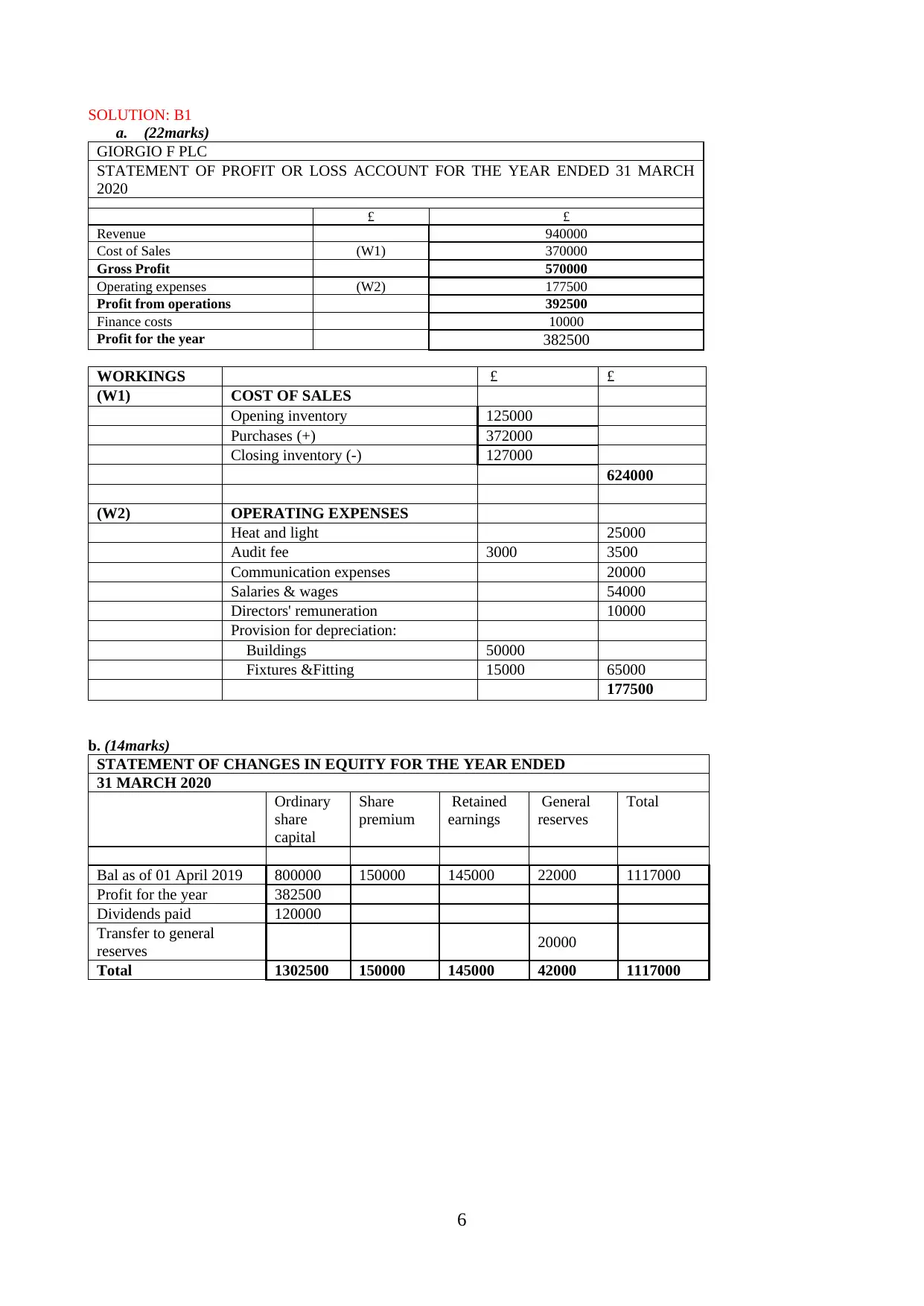
SOLUTION: B1
a. (22marks)
GIORGIO F PLC
STATEMENT OF PROFIT OR LOSS ACCOUNT FOR THE YEAR ENDED 31 MARCH
2020
£ £
Revenue 940000
Cost of Sales (W1) 370000
Gross Profit 570000
Operating expenses (W2) 177500
Profit from operations 392500
Finance costs 10000
Profit for the year 382500
WORKINGS £ £
(W1) COST OF SALES
Opening inventory 125000
Purchases (+) 372000
Closing inventory (-) 127000
624000
(W2) OPERATING EXPENSES
Heat and light 25000
Audit fee 3000 3500
Communication expenses 20000
Salaries & wages 54000
Directors' remuneration 10000
Provision for depreciation:
Buildings 50000
Fixtures &Fitting 15000 65000
177500
b. (14marks)
STATEMENT OF CHANGES IN EQUITY FOR THE YEAR ENDED
31 MARCH 2020
Ordinary
share
capital
Share
premium
Retained
earnings
General
reserves
Total
Bal as of 01 April 2019 800000 150000 145000 22000 1117000
Profit for the year 382500
Dividends paid 120000
Transfer to general
reserves 20000
Total 1302500 150000 145000 42000 1117000
6
a. (22marks)
GIORGIO F PLC
STATEMENT OF PROFIT OR LOSS ACCOUNT FOR THE YEAR ENDED 31 MARCH
2020
£ £
Revenue 940000
Cost of Sales (W1) 370000
Gross Profit 570000
Operating expenses (W2) 177500
Profit from operations 392500
Finance costs 10000
Profit for the year 382500
WORKINGS £ £
(W1) COST OF SALES
Opening inventory 125000
Purchases (+) 372000
Closing inventory (-) 127000
624000
(W2) OPERATING EXPENSES
Heat and light 25000
Audit fee 3000 3500
Communication expenses 20000
Salaries & wages 54000
Directors' remuneration 10000
Provision for depreciation:
Buildings 50000
Fixtures &Fitting 15000 65000
177500
b. (14marks)
STATEMENT OF CHANGES IN EQUITY FOR THE YEAR ENDED
31 MARCH 2020
Ordinary
share
capital
Share
premium
Retained
earnings
General
reserves
Total
Bal as of 01 April 2019 800000 150000 145000 22000 1117000
Profit for the year 382500
Dividends paid 120000
Transfer to general
reserves 20000
Total 1302500 150000 145000 42000 1117000
6
⊘ This is a preview!⊘
Do you want full access?
Subscribe today to unlock all pages.

Trusted by 1+ million students worldwide
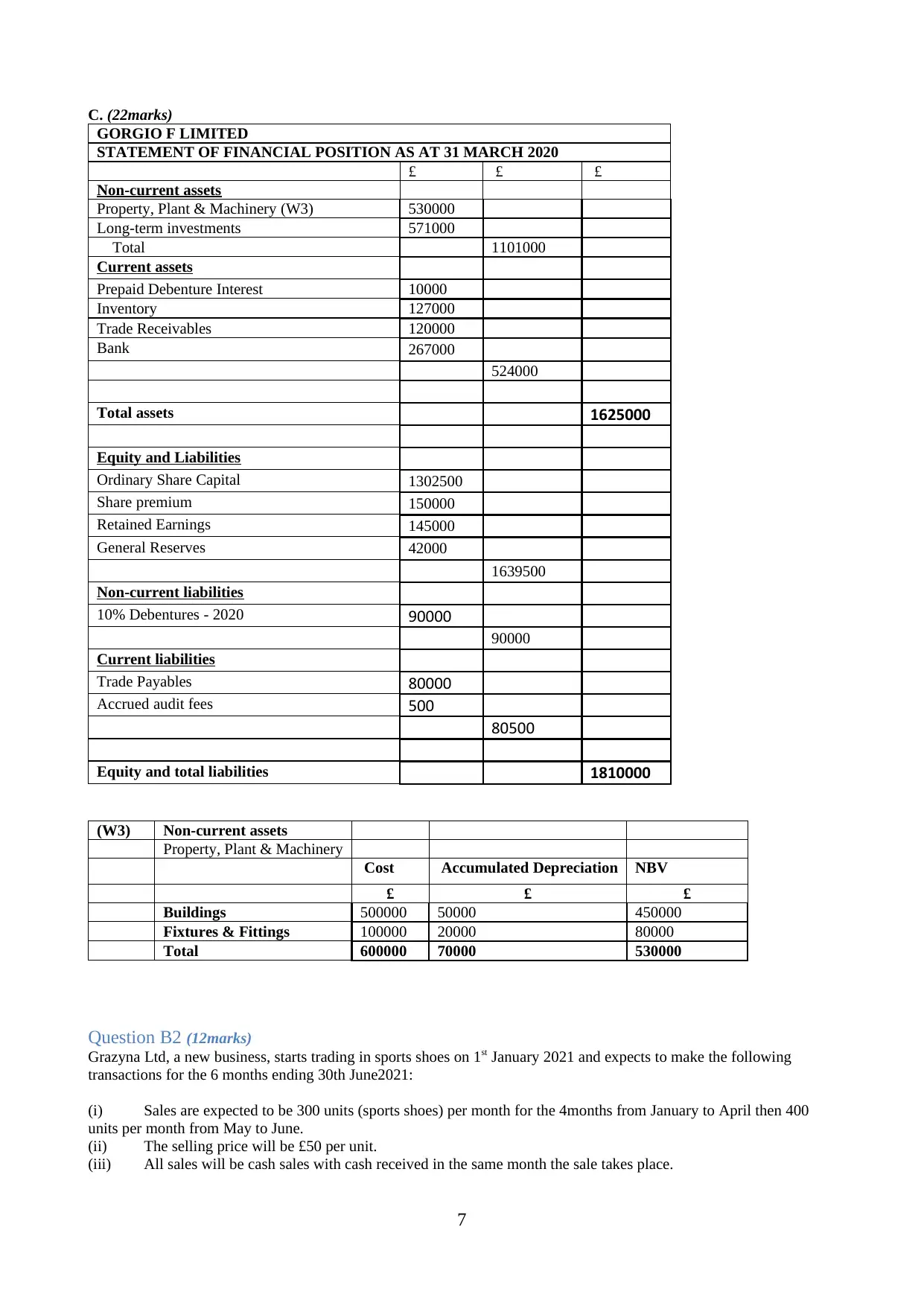
C. (22marks)
GORGIO F LIMITED
STATEMENT OF FINANCIAL POSITION AS AT 31 MARCH 2020
£ £ £
Non-current assets
Property, Plant & Machinery (W3) 530000
Long-term investments 571000
Total 1101000
Current assets
Prepaid Debenture Interest 10000
Inventory 127000
Trade Receivables 120000
Bank 267000
524000
Total assets 1625000
Equity and Liabilities
Ordinary Share Capital 1302500
Share premium 150000
Retained Earnings 145000
General Reserves 42000
1639500
Non-current liabilities
10% Debentures - 2020 90000
90000
Current liabilities
Trade Payables 80000
Accrued audit fees 500
80500
Equity and total liabilities 1810000
(W3) Non-current assets
Property, Plant & Machinery
Cost Accumulated Depreciation NBV
£ £ £
Buildings 500000 50000 450000
Fixtures & Fittings 100000 20000 80000
Total 600000 70000 530000
Question B2 (12marks)
Grazyna Ltd, a new business, starts trading in sports shoes on 1st January 2021 and expects to make the following
transactions for the 6 months ending 30th June2021:
(i) Sales are expected to be 300 units (sports shoes) per month for the 4months from January to April then 400
units per month from May to June.
(ii) The selling price will be £50 per unit.
(iii) All sales will be cash sales with cash received in the same month the sale takes place.
7
GORGIO F LIMITED
STATEMENT OF FINANCIAL POSITION AS AT 31 MARCH 2020
£ £ £
Non-current assets
Property, Plant & Machinery (W3) 530000
Long-term investments 571000
Total 1101000
Current assets
Prepaid Debenture Interest 10000
Inventory 127000
Trade Receivables 120000
Bank 267000
524000
Total assets 1625000
Equity and Liabilities
Ordinary Share Capital 1302500
Share premium 150000
Retained Earnings 145000
General Reserves 42000
1639500
Non-current liabilities
10% Debentures - 2020 90000
90000
Current liabilities
Trade Payables 80000
Accrued audit fees 500
80500
Equity and total liabilities 1810000
(W3) Non-current assets
Property, Plant & Machinery
Cost Accumulated Depreciation NBV
£ £ £
Buildings 500000 50000 450000
Fixtures & Fittings 100000 20000 80000
Total 600000 70000 530000
Question B2 (12marks)
Grazyna Ltd, a new business, starts trading in sports shoes on 1st January 2021 and expects to make the following
transactions for the 6 months ending 30th June2021:
(i) Sales are expected to be 300 units (sports shoes) per month for the 4months from January to April then 400
units per month from May to June.
(ii) The selling price will be £50 per unit.
(iii) All sales will be cash sales with cash received in the same month the sale takes place.
7
Paraphrase This Document
Need a fresh take? Get an instant paraphrase of this document with our AI Paraphraser
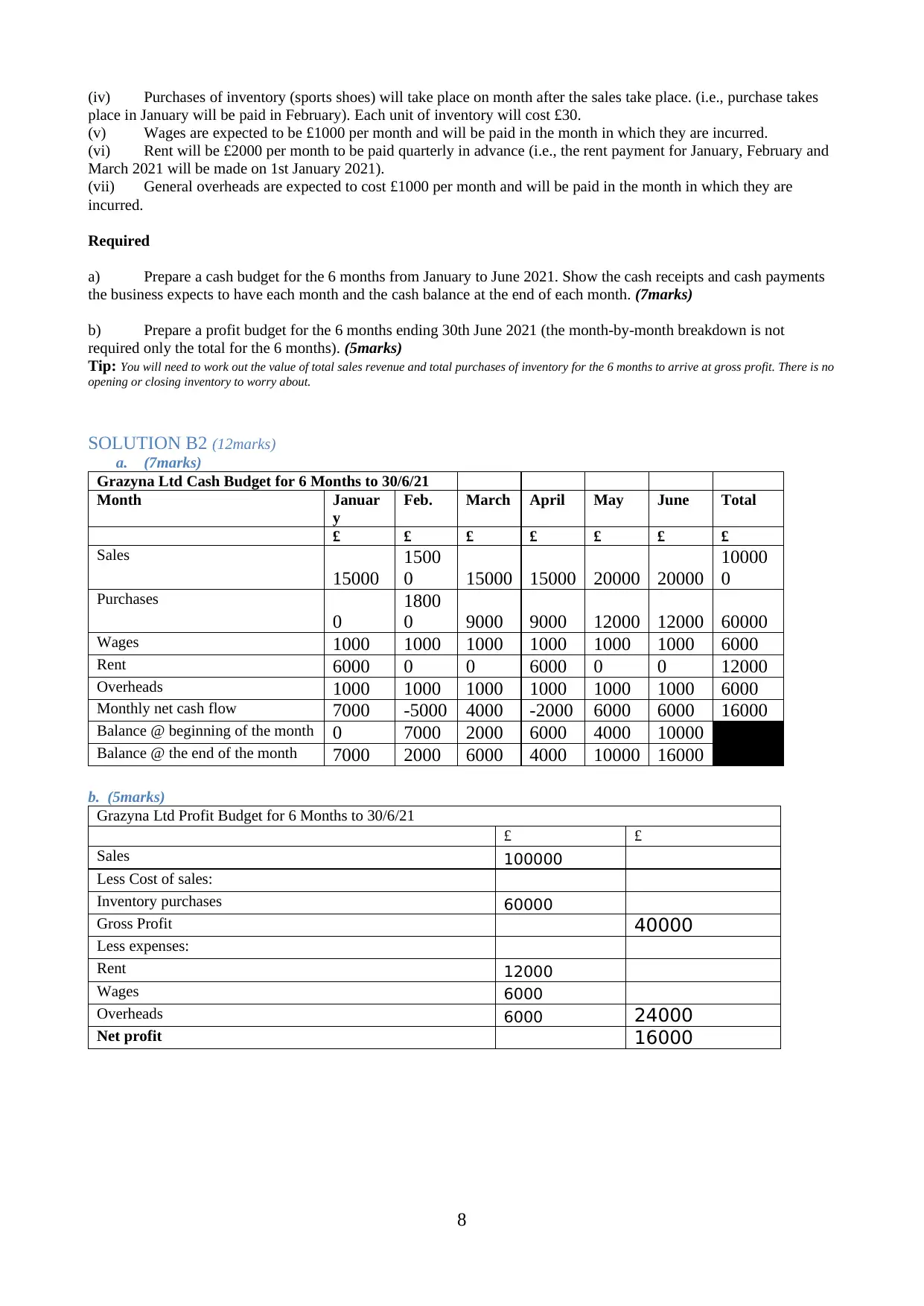
(iv) Purchases of inventory (sports shoes) will take place on month after the sales take place. (i.e., purchase takes
place in January will be paid in February). Each unit of inventory will cost £30.
(v) Wages are expected to be £1000 per month and will be paid in the month in which they are incurred.
(vi) Rent will be £2000 per month to be paid quarterly in advance (i.e., the rent payment for January, February and
March 2021 will be made on 1st January 2021).
(vii) General overheads are expected to cost £1000 per month and will be paid in the month in which they are
incurred.
Required
a) Prepare a cash budget for the 6 months from January to June 2021. Show the cash receipts and cash payments
the business expects to have each month and the cash balance at the end of each month. (7marks)
b) Prepare a profit budget for the 6 months ending 30th June 2021 (the month-by-month breakdown is not
required only the total for the 6 months). (5marks)
Tip: You will need to work out the value of total sales revenue and total purchases of inventory for the 6 months to arrive at gross profit. There is no
opening or closing inventory to worry about.
SOLUTION B2 (12marks)
a. (7marks)
Grazyna Ltd Cash Budget for 6 Months to 30/6/21
Month Januar
y
Feb. March April May June Total
£ £ £ £ £ £ £
Sales
15000
1500
0 15000 15000 20000 20000
10000
0
Purchases
0
1800
0 9000 9000 12000 12000 60000
Wages 1000 1000 1000 1000 1000 1000 6000
Rent 6000 0 0 6000 0 0 12000
Overheads 1000 1000 1000 1000 1000 1000 6000
Monthly net cash flow 7000 -5000 4000 -2000 6000 6000 16000
Balance @ beginning of the month 0 7000 2000 6000 4000 10000
Balance @ the end of the month 7000 2000 6000 4000 10000 16000
b. (5marks)
Grazyna Ltd Profit Budget for 6 Months to 30/6/21
£ £
Sales 100000
Less Cost of sales:
Inventory purchases 60000
Gross Profit 40000
Less expenses:
Rent 12000
Wages 6000
Overheads 6000 24000
Net profit 16000
8
place in January will be paid in February). Each unit of inventory will cost £30.
(v) Wages are expected to be £1000 per month and will be paid in the month in which they are incurred.
(vi) Rent will be £2000 per month to be paid quarterly in advance (i.e., the rent payment for January, February and
March 2021 will be made on 1st January 2021).
(vii) General overheads are expected to cost £1000 per month and will be paid in the month in which they are
incurred.
Required
a) Prepare a cash budget for the 6 months from January to June 2021. Show the cash receipts and cash payments
the business expects to have each month and the cash balance at the end of each month. (7marks)
b) Prepare a profit budget for the 6 months ending 30th June 2021 (the month-by-month breakdown is not
required only the total for the 6 months). (5marks)
Tip: You will need to work out the value of total sales revenue and total purchases of inventory for the 6 months to arrive at gross profit. There is no
opening or closing inventory to worry about.
SOLUTION B2 (12marks)
a. (7marks)
Grazyna Ltd Cash Budget for 6 Months to 30/6/21
Month Januar
y
Feb. March April May June Total
£ £ £ £ £ £ £
Sales
15000
1500
0 15000 15000 20000 20000
10000
0
Purchases
0
1800
0 9000 9000 12000 12000 60000
Wages 1000 1000 1000 1000 1000 1000 6000
Rent 6000 0 0 6000 0 0 12000
Overheads 1000 1000 1000 1000 1000 1000 6000
Monthly net cash flow 7000 -5000 4000 -2000 6000 6000 16000
Balance @ beginning of the month 0 7000 2000 6000 4000 10000
Balance @ the end of the month 7000 2000 6000 4000 10000 16000
b. (5marks)
Grazyna Ltd Profit Budget for 6 Months to 30/6/21
£ £
Sales 100000
Less Cost of sales:
Inventory purchases 60000
Gross Profit 40000
Less expenses:
Rent 12000
Wages 6000
Overheads 6000 24000
Net profit 16000
8
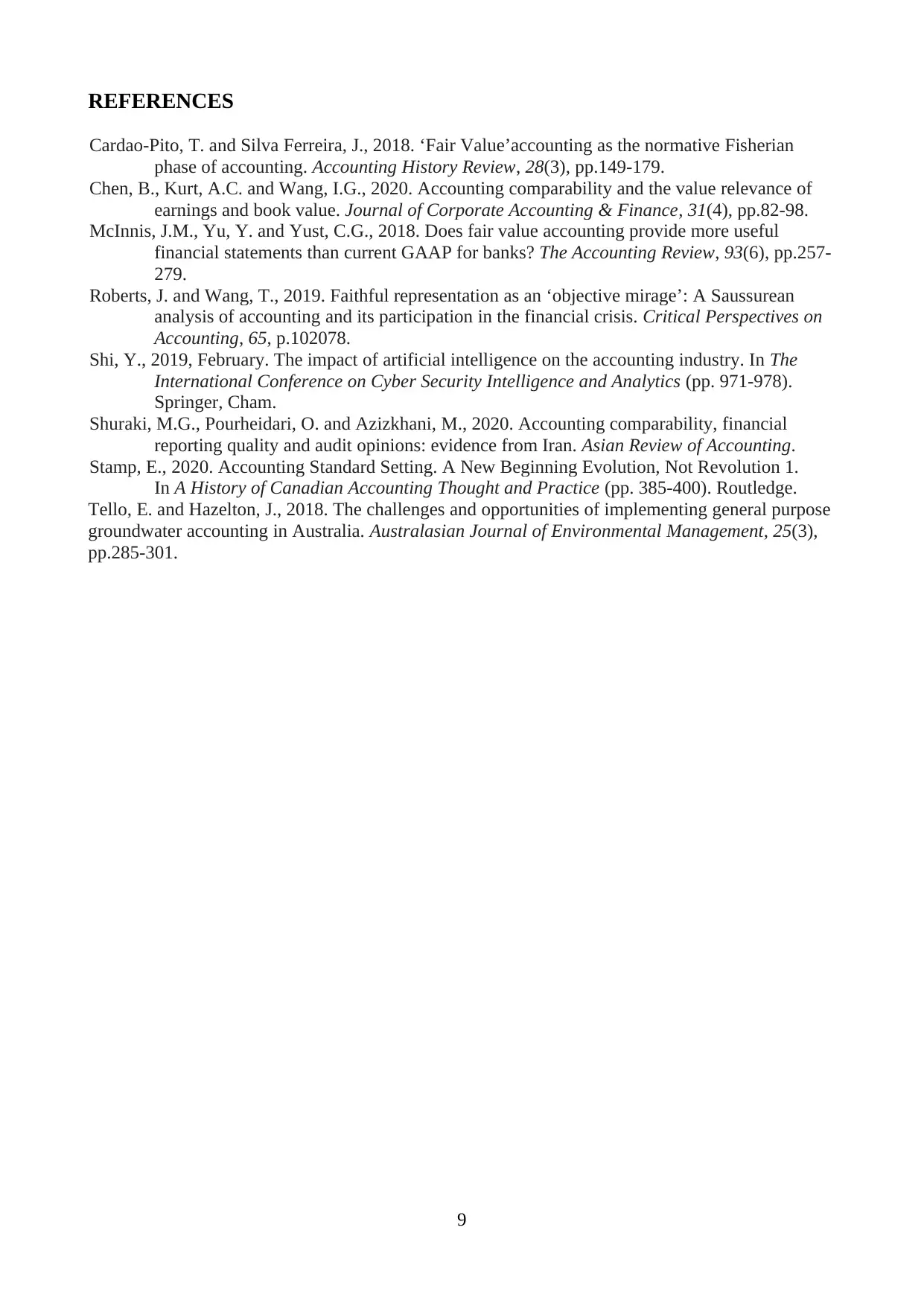
REFERENCES
Cardao-Pito, T. and Silva Ferreira, J., 2018. ‘Fair Value’accounting as the normative Fisherian
phase of accounting. Accounting History Review, 28(3), pp.149-179.
Chen, B., Kurt, A.C. and Wang, I.G., 2020. Accounting comparability and the value relevance of
earnings and book value. Journal of Corporate Accounting & Finance, 31(4), pp.82-98.
McInnis, J.M., Yu, Y. and Yust, C.G., 2018. Does fair value accounting provide more useful
financial statements than current GAAP for banks? The Accounting Review, 93(6), pp.257-
279.
Roberts, J. and Wang, T., 2019. Faithful representation as an ‘objective mirage’: A Saussurean
analysis of accounting and its participation in the financial crisis. Critical Perspectives on
Accounting, 65, p.102078.
Shi, Y., 2019, February. The impact of artificial intelligence on the accounting industry. In The
International Conference on Cyber Security Intelligence and Analytics (pp. 971-978).
Springer, Cham.
Shuraki, M.G., Pourheidari, O. and Azizkhani, M., 2020. Accounting comparability, financial
reporting quality and audit opinions: evidence from Iran. Asian Review of Accounting.
Stamp, E., 2020. Accounting Standard Setting. A New Beginning Evolution, Not Revolution 1.
In A History of Canadian Accounting Thought and Practice (pp. 385-400). Routledge.
Tello, E. and Hazelton, J., 2018. The challenges and opportunities of implementing general purpose
groundwater accounting in Australia. Australasian Journal of Environmental Management, 25(3),
pp.285-301.
9
Cardao-Pito, T. and Silva Ferreira, J., 2018. ‘Fair Value’accounting as the normative Fisherian
phase of accounting. Accounting History Review, 28(3), pp.149-179.
Chen, B., Kurt, A.C. and Wang, I.G., 2020. Accounting comparability and the value relevance of
earnings and book value. Journal of Corporate Accounting & Finance, 31(4), pp.82-98.
McInnis, J.M., Yu, Y. and Yust, C.G., 2018. Does fair value accounting provide more useful
financial statements than current GAAP for banks? The Accounting Review, 93(6), pp.257-
279.
Roberts, J. and Wang, T., 2019. Faithful representation as an ‘objective mirage’: A Saussurean
analysis of accounting and its participation in the financial crisis. Critical Perspectives on
Accounting, 65, p.102078.
Shi, Y., 2019, February. The impact of artificial intelligence on the accounting industry. In The
International Conference on Cyber Security Intelligence and Analytics (pp. 971-978).
Springer, Cham.
Shuraki, M.G., Pourheidari, O. and Azizkhani, M., 2020. Accounting comparability, financial
reporting quality and audit opinions: evidence from Iran. Asian Review of Accounting.
Stamp, E., 2020. Accounting Standard Setting. A New Beginning Evolution, Not Revolution 1.
In A History of Canadian Accounting Thought and Practice (pp. 385-400). Routledge.
Tello, E. and Hazelton, J., 2018. The challenges and opportunities of implementing general purpose
groundwater accounting in Australia. Australasian Journal of Environmental Management, 25(3),
pp.285-301.
9
⊘ This is a preview!⊘
Do you want full access?
Subscribe today to unlock all pages.

Trusted by 1+ million students worldwide
1 out of 9
Related Documents
Your All-in-One AI-Powered Toolkit for Academic Success.
+13062052269
info@desklib.com
Available 24*7 on WhatsApp / Email
![[object Object]](/_next/static/media/star-bottom.7253800d.svg)
Unlock your academic potential
Copyright © 2020–2026 A2Z Services. All Rights Reserved. Developed and managed by ZUCOL.


